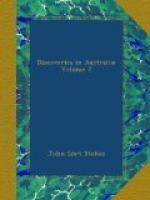The extreme altitude of Sea Range is from 7 to 800 feet, and of the hills last seen, near Mount Regret, from 4 to 500. The distinctive formation common to both consists in their level summits, within twenty feet of which a precipitous wall of rock, of a reddish hue, runs along the hillside.
VEGETABLE PRODUCTIONS.
The upper portion of the valley through which the river passes varies in its nature from treeless, stony plains to rich alluvial flats, lightly timbered with a white-stemmed gum. The banks are steep and high, thickly clothed with the acacia, drooping eucalyptus, and tall reeds. The various lake-like reaches had, of course, no perceptible stream, but their banks, no less than the dry patches in the bed of the river, satisfied us that the Victoria had recently been, and in all probability would soon again become, a large and rapid river.
GOUTY-STEM TREE.
Among the most curious vegetable productions along its banks are the silk cotton-tree and the gouty-stem tree. The latter has been already mentioned by Captains King and Grey, and here attains a great size: it bears a very fragrant white flower, not unlike the jasmine; the fruit is used by the natives, and found to be a very nutritious article of food, something similar to a coconut. Not having previously noticed it in this neighbourhood I conclude this to be the northern limit of its growth. The reader will remember my having before alluded to seeing it near the mouth of Fitzroy River, where I have also mentioned the extent of coast on which we found it, and given the limits of its indigenous empire, extending not quite over two degrees of latitude. The peculiar character of the tree I leave the reader to learn from the woodcuts annexed.
ITS FRUIT.
That containing the fruit* is from a specimen obtained near the Fitzroy, as it was in flower when I saw it in the month of November on the banks of the Victoria.
(Footnote. For description of this fruit, see Volume 1.)




